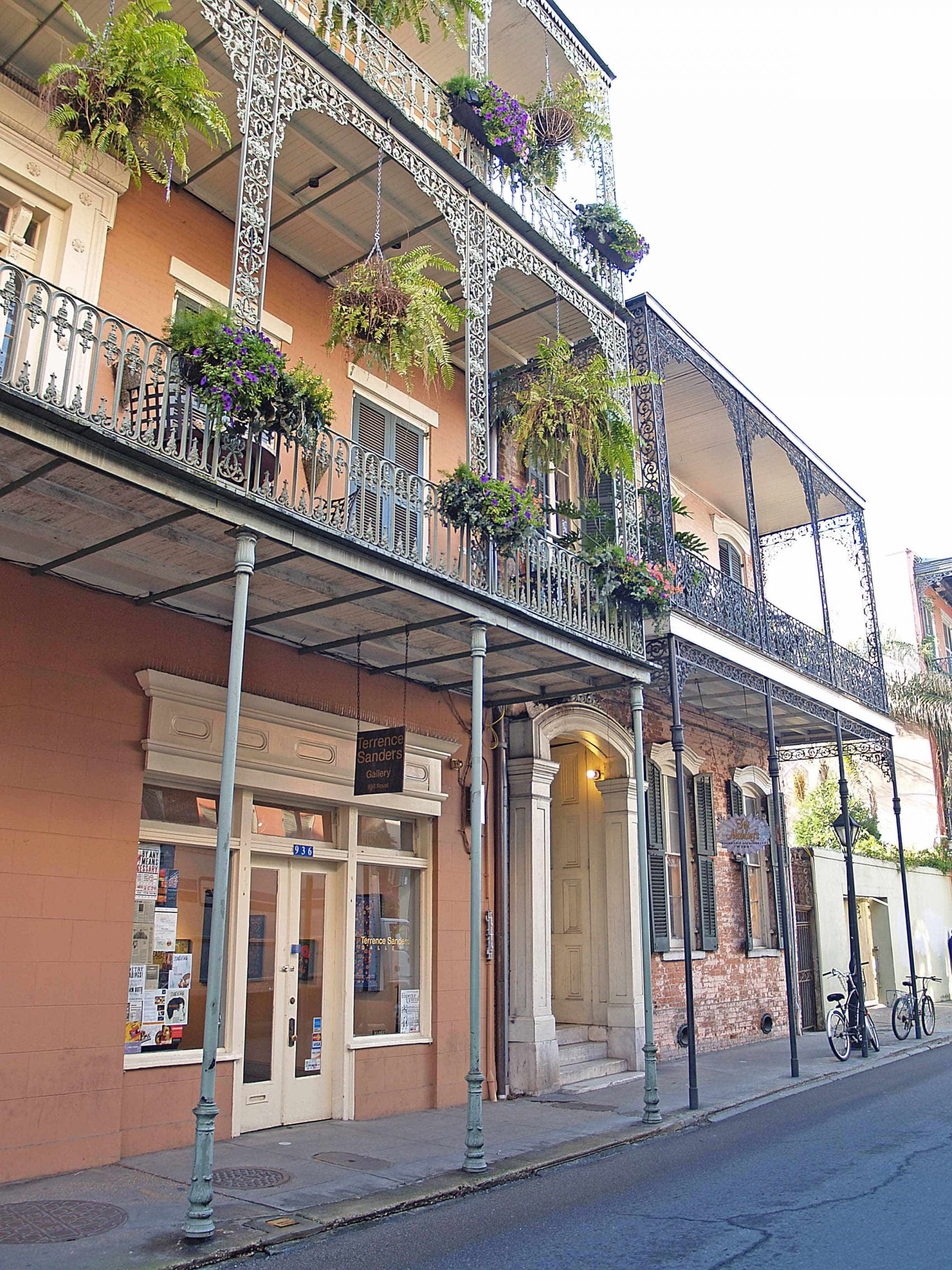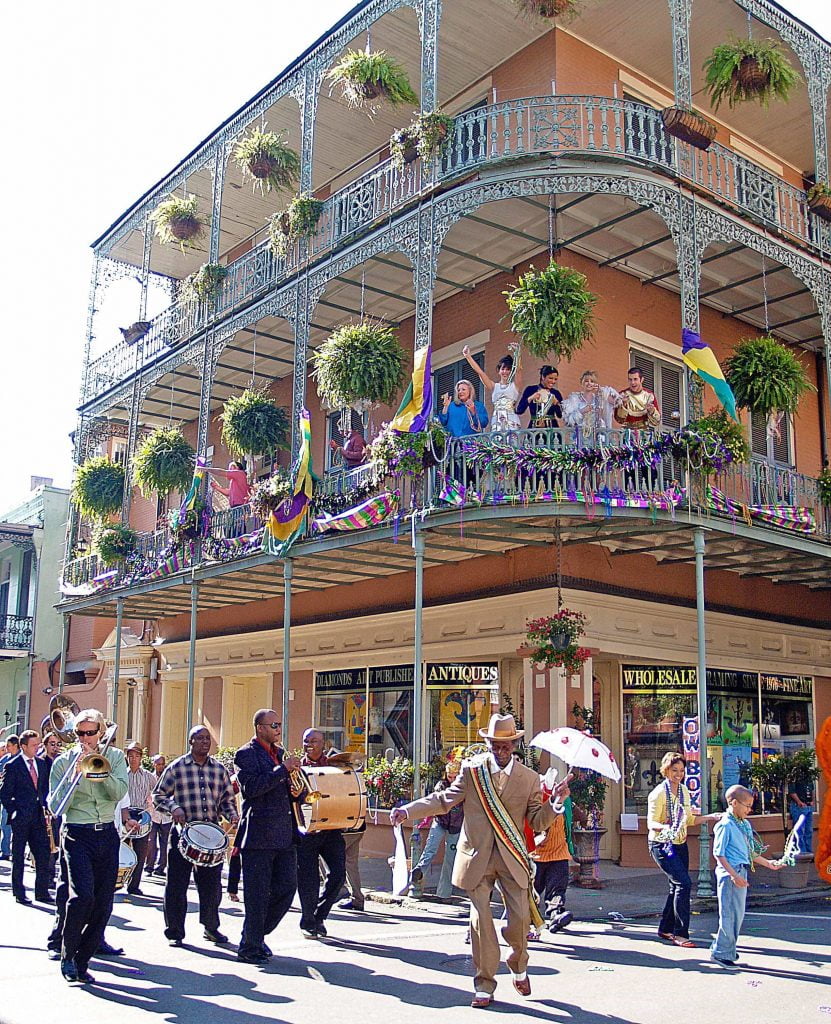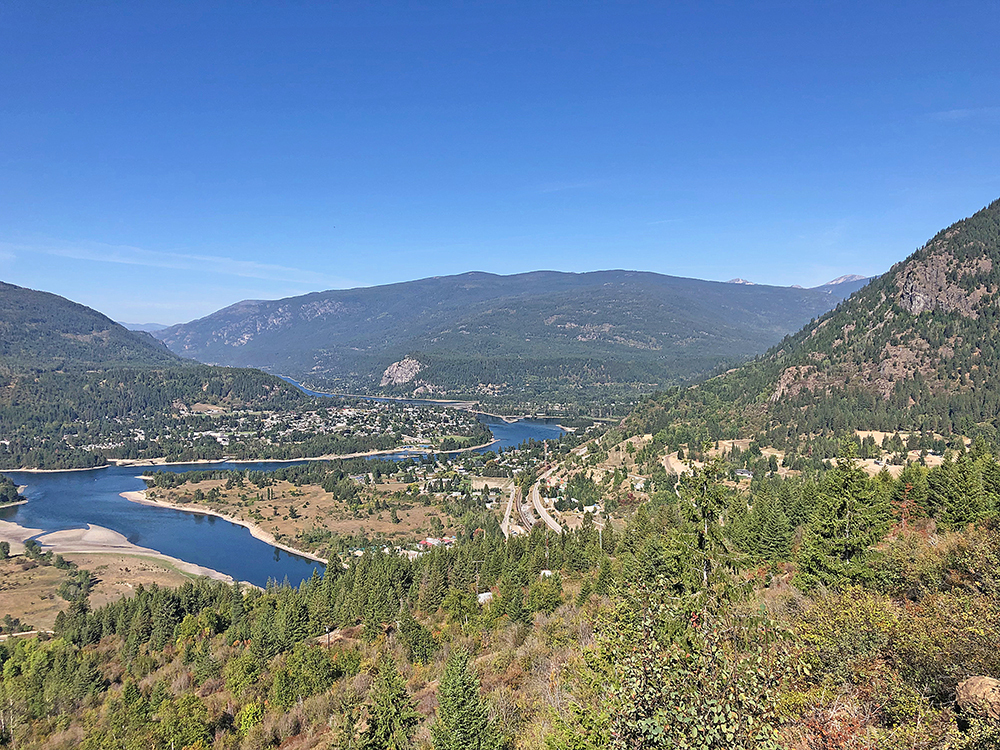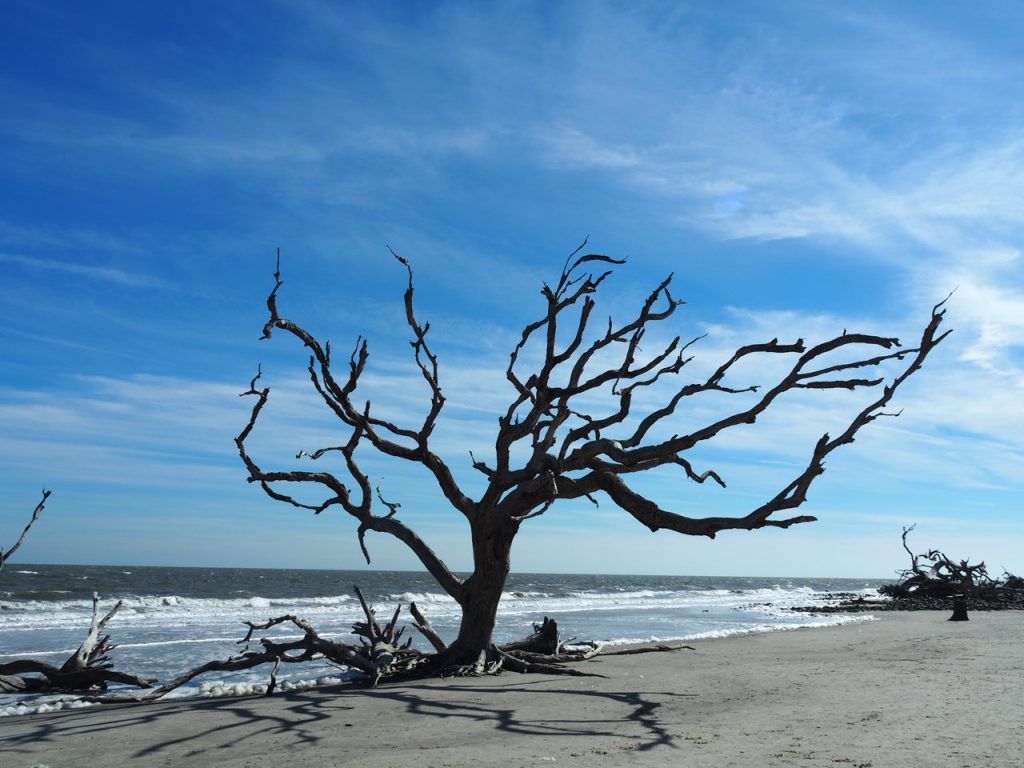I have a plate of what could be the best bread pudding in all of Louisiana. It’s studded with raisins, drizzled with decadent whiskey sauce and just happens to be the one recipe the chef at The Court of Two Sisters is never allowed to change. This is unique in a city that celebrates its chameleon-like culture.
Finding one pigeonhole to describe New Orleans is an impossible task. Sophisticated yet unpretentious. Raucous yet subdued. Au courant, but steeped in history. If you come looking for great food, you’ll find it by the plateful. If you want history, look no farther. Music and culture? New Orleans (fondly nicknamed NOLA) is your place. And architecture… the historic centre has the largest concentration of 19th-century buildings in the nation.
ARRIVING & GETTING SETTLED
Although the French Quarter is usually on everyone’s bucket list, there are many other neighbourhoods that also beg to be explored. NOLA’s narrow laneways and tight parking are not RV friendly, so a little planning is in order. This is not a downtown that you roar into with your Class A without inviting stress and headaches.
Immediately across the Mississippi River is Bayou Segnette State Park, our choice for a dose of nature close to the big city dazzle. There are 98 well-spaced sites with electrical and water (US$25-33, depending on date), comfort stations, laundry facilities, playground, nature trail and dump station. It’s a 30-minute drive across the bridge into downtown and, for modest-size rigs, there’s a public parking lot behind the U.S. Mint museum at the edge of the French Quarter (2124 Decatur St; metered cash and credit cards).
A less-stressful alternative is to drive to nearby Algiers Point (15 km from the state park), park in the ferry lot and hop onto the Algiers Ferry across the Mississippi to Canal Street. The parking fee is modest, it’s a half hour trip each way and the ferry runs every 30 minutes. Besides being deposited at the edge of the French Quarter, there’s a wonderful skyline view from the ferry.
If you’re willing to dig deeper into your wallet (US$105/night), the French Quarter RV Resort is walking distance to the laneways, clubs and markets of the French Quarter. Fifty-two paved sites accommodate all sizes of RVs with full hookups, cable TV, a community pool and hot tub.
Just a half-hour (34 km) west of the French Quarter is the New Orleans KOA with limited shuttle service
and regular city buses into downtown. Sites with full hookups range up to 100 feet in length. There’s a laundry, WiFi, playground, dog park and dog walking services that can be arranged through campground staff.
CLASSIC NEW ORLEANS NEIGHBOURHOODS
New Orleans – like many large cities – is made up of distinct neighbourhoods. Many are walkable and others are easily explored using the city’s historic streetcars. We always visit the classic stops in the French Quarter and we’ve seen charming sides of NOLA through its other neighbourhoods.
While the French Quarter is infamous for its late night debauchery, we prefer to rise early and roam the streets in the mornings, to watch the city wake up and get going. The street cleaners are moving about doing their business, the light is magical and the bakeries are pulling their first day’s goods from the oven. Wandering is the best way to experience this historic heart of the city that hugs the riverside.
While Bourbon Street is the city’s most famous stretch of pavement, we prefer to spend less time surrounded by the neon signs, tacky shops and crowds of inebriated partiers. Instead, we head one or two streets over and window shop the antique dealers along Royal Street, see the performers and fortune tellers in Jackson Square and stroll along the natural levees of the mighty Mississippi River. Seen at the right time, the French Quarter shows off its atmospheric bars, small courtyards, ironwork balconies and stunning Colonial and Creole architecture, with history around every corner.
Above: Street parades are a common sight in the French Quarter. Revellers often join in from the balconies. Below: Music is found in small venues and on most street corners, especially in the French Quarter of New Orleans.

Just north of the French Quarter is Tremé, the country’s oldest African-American neighbourhood where streets are lined with colourful Creole cottages and cozy shotgun-style homes; a “shotgun house” is one where a straight hallway connects the front and back doors, so a clean shot could be fired from the street, right out the back door. Louis Armstrong Park and Congo Square trace their roots back to the 18th century, as gathering spots for enslaved Africans to meet, dance and sing. These cultural expressions developed into the famous “Second Line” (brass band parades on the move) and eventually birthed New Orleans jazz and rhythm and blues.
Established in 1835, the St. Charles streetcar line is the oldest continuously operating street railway in the world and the city’s best-known route. The St. Charles line is protected on the National Register of Historic Landmarks, and looks and operates as it did in the 1920s, rumbling along a 10-km crescent that takes in the grand mansions on the high ground of Uptown and The Garden District.
Riding one of the city’s famed streetcars is a great way to explore areas outside of the French Quarter core. A public transportation Jazzy Pass allows unlimited rides on both the buses and the streetcars; one-, three- and five-day passes cost US$3/day (cash and exact change only).

FOOD & DRINK
In food-obsessed New Orleans, they start talking about dinner while wiping the dishes from lunch. Food in this city, especially Creole and Cajun cooking (the latter is spicier and more rustic), is an almost transcendent experience. There are hundreds of places to indulge, from small sandwich shops and bakeries to five-star eateries complete with white linen tablecloths, all price ranges, all cooking styles. Confession: We’ve eaten our way across downtown, and here are a few of our favourites:
Sooner or later everyone indulges in a fresh, hot, icing sugar–covered beignet. The most famous bakery to serve up the iconic pastries is Café du Monde in the French Market, but our favourite is the French bistro-style Café Beignet on Royal Street, where the locals gather, coffee in one hand and newspaper in the other. Sit in the converted carriage house or in the small courtyard – from late afternoon through the evening, there’s live music.
When we want to try all the NOLA classics – including turtle soup, corn grits, Creole jambalaya, shrimp étouffée, bread pudding and bananas foster – we head for the Jazz Brunch at The Court of Two Sisters. Brunch is served seven days a week in the French Quarter’s largest courtyard, shaded by a 120-year-old wisteria. While we ate, live jazz percolated across the courtyard.
The deal of the day belonged to the hubcap-size muffuletta at Central Grocery on Decatur Street, across from the French Market. The third-generation grocery store and deli oozes with character, not least of which is their invention of the muffuletta. The monster-size sandwich is made with meats sliced in-house, fresh-baked bread and family-recipe Italian olive salad.
For affordable takeout we ordered at Remoulade, the casual little sister of upscale Arnaud’s. We took our containers of shrimp Creole and Andouille sausage jambalaya, sat on a park bench and had a delicious dinner watching the boats chug up and down the river.
They say the Hotel Monteleone is haunted, but if you just stop for a drink at the rotating Carousel Bar you should be safe. The Carousel caught the imagination of American literary giants like Ernest Hemingway and William Faulkner, who included it in their pages. Fun trivia: Truman Capote claimed he was born in the hotel.
MUSIC
If you can, get front-row seats at Preservation Hall, the classic setting for traditional New Orleans jazz. It’s old and hot and cramped, but the music is as authentic as I gets, played by some of the city’s finest jazz artists. New daytime shows will focus on the history of the venue; “If This Hall Could Speak” mixes storytelling and history from the perspective of its musicians, some of whom have been performing at the hall since its early days in the 1960s. The one-hour show helps audiences understand the history of New Orleans jazz from the point of view of those who have helped create, sustain and evolve the genre.
It seems that musicians set up on almost every street corner and public square (especially Jackson Square, in front of St. Louis Cathedral). It’s part of what gives NOLA its unique character. They work for tips, so be generous.
Just beside the French Quarter, the artsy, vibrant Marigny District is home to Frenchmen Street, a hotbed of small jazz clubs where locals go to soak up authentic music played by NOLA musicians. We hopped in and out of clubs like Snug Harbor, Three Muses, The Spotted Cat and Blue Nile, where the tunes played on through the wee hours.
MUST-DO MUSEUMS
When the U.S. Congress resolved that, “Jazz is hereby designated as a rare and valuable national American treasure,” it established the New Orleans Jazz National Historic Park (part of the National Park Service) in the French Quarter. It’s a great spot to learn about jazz history or sign up for a guided Jazz History Walking Tour. The park also produces concerts at the New Orleans Jazz Museum (a state museum) in the Old U.S. Mint building at the east end of the French Quarter. The museum boasts the world’s largest collection of instruments owned and played by jazz greats, including the cornet Louis Armstrong learned to play as a young boy. There are also photos, sheet music, manuscripts and recordings, including a 1917 disc of the first jazz recording ever made.
The National WWII Museum is a world-class, immersive experience telling the history of American participation in the global conflict through detailed exhibits, multimedia experiences and the personal stories of those it touched. A highlight is the 4D-experience called “Beyond All Boundaries.” Most people don’t think of this kind of history museum when they think of fun-loving New Orleans, but it’s a stop that shouldn’t be missed.
The Presbytère (part of the Louisiana State Museum) flanks St. Louis Cathedral in the French Quarter. Its two permanent exhibits tackle the topics of the city’s Mardi Gras and the challenge of living with hurricanes.
The French Quarter Galleries in The Historic New Orleans Collection on Royal Street explore how and why the unique neighbourhood developed, using original artifacts and state-of-the-art interactive video and audio technologies. The French Quarter by Night film spans three centuries, from a mosquito infested Mississippi River bank to the modern Mardi Gras frivolities.
The new Louisiana Children’s Museum in City Park features interactive, educational exhibits, a Mississippi water exhibit that shows the importance of the “river highway,” learning gardens and interpretive wetlands.
The Sazerac House treats visitors to a free, high-tech journey through the history and culture of spirits in New Orleans, including the world-famous Sazerac Cocktail. Visitors sidle up to the video bar, push a button and order a drink; the digital bartender creates the drink in front of you and slides it across the virtual counter.
Visits to NOLA’s famed above-ground cemeteries have always been popular. The city’s oldest, St. Louis #1 in the Tremé neighbourhood, recently was restricted to licensed, guided tours. It’s the final resting place of Marie Laveau, the 19th-century voodoo queen of New Orleans, as well as home to actor Nicolas Cage’s strange (as yet empty) pyramid tomb. The city’s other cemeteries can be explored without a guide.
MARK THESE DATES in 2020
Mardi Gras: February 25
New Orleans Jazz & Heritage Festival: April 23-May 3
Satchmo SummerFest: July 31-August 2





